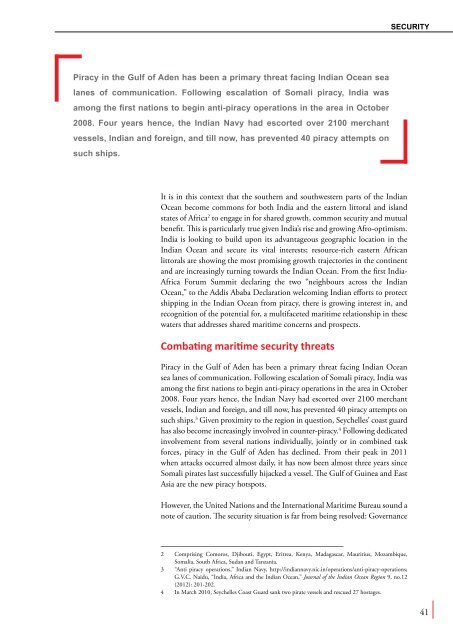Common Futures
II3UUw
II3UUw
Create successful ePaper yourself
Turn your PDF publications into a flip-book with our unique Google optimized e-Paper software.
security<br />
Piracy in the Gulf of Aden has been a primary threat facing Indian Ocean sea<br />
lanes of communication. Following escalation of Somali piracy, India was<br />
among the first nations to begin anti-piracy operations in the area in October<br />
2008. Four years hence, the Indian Navy had escorted over 2100 merchant<br />
vessels, Indian and foreign, and till now, has prevented 40 piracy attempts on<br />
such ships.<br />
It is in this context that the southern and southwestern parts of the Indian<br />
Ocean become commons for both India and the eastern littoral and island<br />
states of Africa 2 to engage in for shared growth, common security and mutual<br />
benefit. This is particularly true given India’s rise and growing Afro-optimism.<br />
India is looking to build upon its advantageous geographic location in the<br />
Indian Ocean and secure its vital interests; resource-rich eastern African<br />
littorals are showing the most promising growth trajectories in the continent<br />
and are increasingly turning towards the Indian Ocean. From the first India-<br />
Africa Forum Summit declaring the two “neighbours across the Indian<br />
Ocean,” to the Addis Ababa Declaration welcoming Indian efforts to protect<br />
shipping in the Indian Ocean from piracy, there is growing interest in, and<br />
recognition of the potential for, a multifaceted maritime relationship in these<br />
waters that addresses shared maritime concerns and prospects.<br />
Combating maritime security threats<br />
Piracy in the Gulf of Aden has been a primary threat facing Indian Ocean<br />
sea lanes of communication. Following escalation of Somali piracy, India was<br />
among the first nations to begin anti-piracy operations in the area in October<br />
2008. Four years hence, the Indian Navy had escorted over 2100 merchant<br />
vessels, Indian and foreign, and till now, has prevented 40 piracy attempts on<br />
such ships. 3 Given proximity to the region in question, Seychelles’ coast guard<br />
has also become increasingly involved in counter-piracy. 4 Following dedicated<br />
involvement from several nations individually, jointly or in combined task<br />
forces, piracy in the Gulf of Aden has declined. From their peak in 2011<br />
when attacks occurred almost daily, it has now been almost three years since<br />
Somali pirates last successfully hijacked a vessel. The Gulf of Guinea and East<br />
Asia are the new piracy hotspots.<br />
However, the United Nations and the International Maritime Bureau sound a<br />
note of caution. The security situation is far from being resolved: Governance<br />
2 Comprising Comoros, Djibouti, Egypt, Eritrea, Kenya, Madagascar, Mauritius, Mozambique,<br />
Somalia, South Africa, Sudan and Tanzania.<br />
3 “Anti piracy operations,” Indian Navy, http://indiannavy.nic.in/operations/anti-piracy-operations;<br />
G.V.C. Naidu, “India, Africa and the Indian Ocean,” Journal of the Indian Ocean Region 9, no.12<br />
(2012): 201-202.<br />
4 In March 2010, Seychelles Coast Guard sank two pirate vessels and rescued 27 hostages.<br />
41








